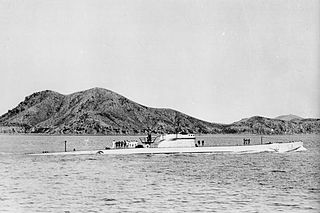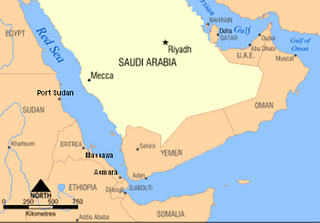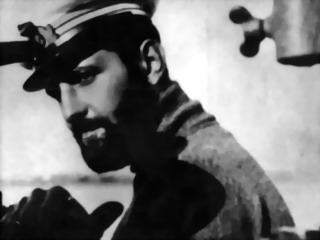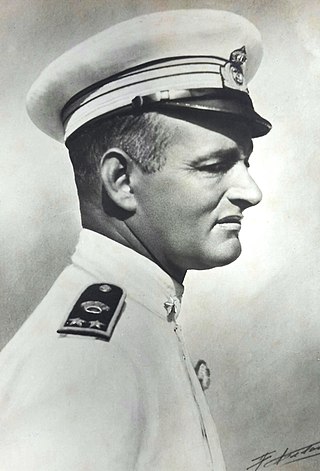An Argonaut is a hero in Greek mythology.

A midget submarine is any submarine under 150 tons, typically operated by a crew of one or two but sometimes up to six or nine, with little or no on-board living accommodation. They normally work with mother ships, from which they are launched and recovered and which provide living accommodation for the crew and support staff.

The Regia Marina (RM) or Royal Italian Navy was the navy of the Kingdom of Italy from 1861 to 1946. In 1946, with the birth of the Italian Republic, the Regia Marina changed its name to Marina Militare.
Imperial Japanese Navy submarines originated with the purchase of five Holland type submarines from the United States in 1904. Japanese submarine forces progressively built up strength and expertise, becoming by the beginning of World War II one of the world's most varied and powerful submarine fleets.
Enrico Toti was one of four Balilla-class submarines built for the Regia Marina during the late 1920s. The boat played a minor role in the Spanish Civil War of 1936–1939 supporting the Spanish Nationalists. She was the only Italian submarine to have sunk a Royal Navy submarine during the Second World War.

A merchant submarine is a type of submarine intended for trade, and being without armaments, it is not considered a warship like most other types of submarines. The intended use would be blockade running, or to dive under Arctic ice.

Barbarigo was a World War II Italian Marcello-class submarine. It was built by the Cantieri Riuniti dell'Adriatico, and was commissioned on 19 September 1938.

The Marcello class was a class of nine submarines built in 1937 and 1938 by CRDA in Trieste for the Royal Italian Navy. Two similar submarines built in 1939 at La Spezia by Oto Melara are sometimes considered part of the class. All eleven served in the Mediterranean Sea at the start of the Second World War. After Provana's 1940 sinking, the remaining boats were transferred to the BETASOM Atlantic submarine base at Bordeaux in August 1940. After four boats had been sunk in the Atlantic, Barbarigo and Comandante Cappellini were then selected for conversion to "transport submarines" in order to exchange rare or irreplaceable trade goods with Japan. Cargo capacity of 160 tons reduced reserve buoyancy from 20–25% to 3.5–6%; and armament was reduced to defensive machine guns. Only Dandolo was in operational condition at the end of the war.

The Red Sea Flotilla was part of the Regia Marina based at Massawa in the colony of Italian Eritrea, part of Italian East Africa. During the Second World War, the Red Sea Flotilla fought the East Indies Station of the Royal Navy from the Italian declaration of war on 10 June 1940 until the fall of Massawa on 8 April 1941.

Gianfranco Gazzana Priaroggia was an officer in the Italian Royal Navy, and was the highest-scoring Italian submarine captain of World War II.

The Balilla class were the first submarines to be built for the Italian navy following the end of World War I. They were large ocean-going cruiser submarines designed to operate in the Indian Ocean based in Italy's East African colonies. The design was double-hulled and based on the German Type UE 2 U-boats, one of which, U-120 was supplied to the Italians as a war reparation. A 425 horsepower (317 kW) auxiliary diesel engine was installed as an extra generator.
The Italian submarine fleet of World War II was the largest in the world at the time, with 116 submarines. It saw action during the Second World War, serving mainly in the Mediterranean. During the conflict 88 submarines, some two-thirds of its total strength, were lost.

The Calvi class was a class of three submarines built by Oderno-Terni-Orlando in Genoa for the Royal Italian Navy. The submarines were built in 1935, and all three served in the Mediterranean at the start of the Second World War. The boats were transferred to the BETASOM Atlantic submarine base at Bordeaux in August 1940. In December 1941 the boats were used for a rescue mission of 254 sailors from the sunken German auxiliary cruiser Atlantis. After Calvi had been sunk, Finzi and Tazzoli were selected for conversion to "transport submarines" in order to exchange rare or irreplaceable trade goods with Japan. Cargo capacity of 160 tons reduced reserve buoyancy from 20–25% to 3.5–6%; and armament was reduced to defensive machine guns.
Pietro Calvi was the lead ship of its class of two submarines built for the Regia Marina during the 1930s. Completed in 1936, she played a minor role in the Spanish Civil War of 1936–1939 supporting the Spanish Nationalists. The submarine made multiple patrols in the Atlantic Ocean during the Second World War, sinking seven Allied ships. Pietro Calvi was rammed and sunk by a British convoy escort in July 1942.
The Cantieri navali Tosi di Taranto is a defunct Italian shipyard founded in 1914 by engineering company Franco Tosi & C. Between World War I and World War II it specialized in building submarines. The company never really recovered from the devastation from World War II and it was one of the first acquisitions of the newly formed financial holding company, Fincantieri, on 29 December 1959. The shipyard closed on 31 December 1990.
The 13.2 mm Breda Model 31 was a widely used Italian heavy machine gun produced by Società Italiana Ernesto Breda and used by the Italian Navy and Italian Army during World War II. At sea it was employed as a light anti-aircraft gun, while on land it was mounted on armored command vehicles where it was used as a heavy machine gun. After World War II it remained in use aboard the patrol boats of the Guardia di Finanza.

Primo Longobardo was an Italian naval officer and submariner during World War II.